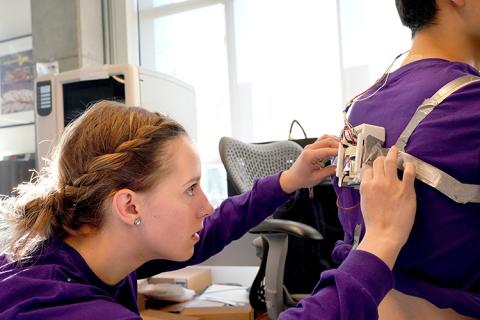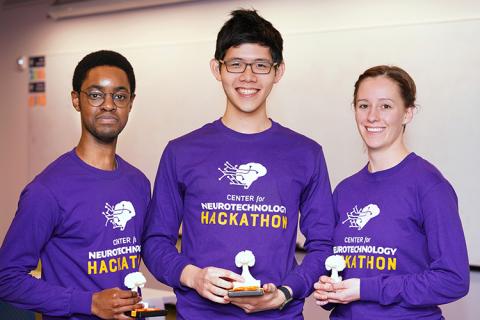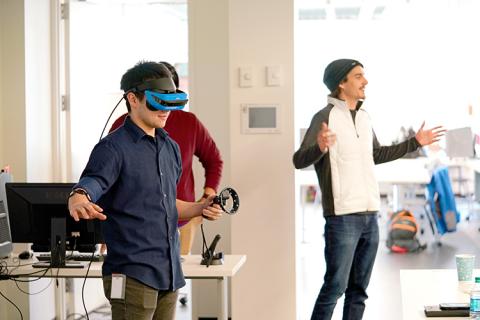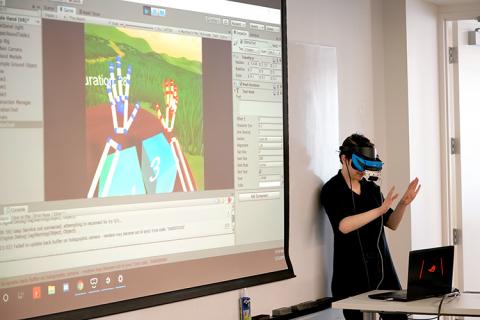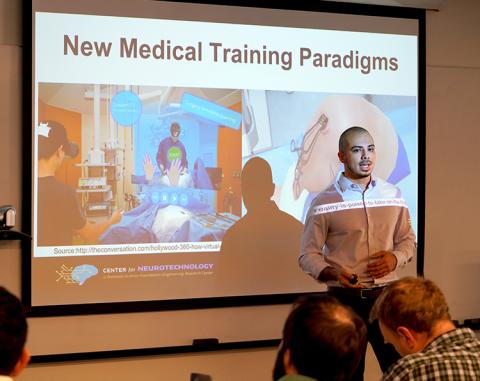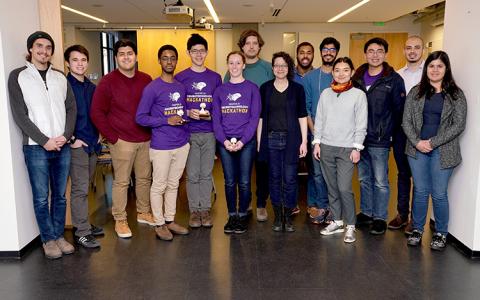Derived from a course for students to create solutions to neural engineering problems, the Center for Neurotechnology (CNT) Hackathon is a weekend-long event where student teams have 36 hours to create novel technology that fulfills the CNT mission: Improve health and function by engineering neural devices.
“This hackathon is a chance to [focus on] neural work with engineering principles. I think it’s fun to commit yourself to a project for a weekend and have that to focus on,” said Jackson Chin, a hackathon participant and senior in bioengineering at the University of Washington (UW).
This year’s hackathon featured five teams representing institutions across the country including the UW, Massachusetts Institute of Technology, Georgia State University, Morehouse College, and Carnegie Mellon University. Participants represented disciplines including neuroscience, computer science, bioengineering, mechanical engineering, and physics, with students at undergraduate and graduate levels.
“Neural engineering is such a broad, interdisciplinary field,” said Richy Yun, a third- year PhD student in bioengineering and hackathon coordinator at the UW. “The whole point is to bring in people with different backgrounds and ideas together outside of lab settings and give them an opportunity to work on something and solve problems.”
Using virtual reality and mixed reality to address neural engineering problems
Unlike traditional hackathons that focus on coding, this hackathon invited its participants to create a device with a hardware and software component.
Yun emphasized that developing something with hardware and software in mind is an integral part of neural engineering.
“My experience in a lab involves a lot of coding and analysis, but half of what I do when running experiments is troubleshooting to come up with ad-hoc connectors and stimulating devices and wires,” Yun said. “I think it’s important to understand how all of that works together, so in the end, you can do the analysis.”
Yun wanted to encourage creativity, so he chose the theme of virtual reality (VR) and augmented reality (AR). Participants were required to analyze bio signals through methods like electromyogram motion capture in their project. Each team received a Microsoft Mixed Reality Headset and access to equipment like arduinos and haptic feedback devices that can measure sensory feedback in response to a task.
Chin’s team focused on using VR to address phantom limb pain, a phenomenon that can occur in people with an amputated limb because of a combat injury, accident, or disease like diabetes. As a result, neurons can rearrange themselves in ways that bring pain, and it affects 80 percent of people with an amputation. One treatment option is called mirror therapy, a reflective illusion where the patient perceives their existing limb as their lost limb and by relaxing their arm muscles induces pain relief.
The goal of the team’s project was to use a VR headset and Myo gesture control armband to create a virtual experience that replicated mirror therapy.
For some participants, creating a product for an end user can be very different than doing research, which focuses on understanding a subject in-depth. The hackathon invites participants to think about how to create a product that can fit into someone's life.
“Most of my lab work is focused on furthering research for research’s sake. I do computational biology and image processing, so I build tools to help research become better,” Chin said. “Here, it’s focused on product development to create something meaningful that can help people.”
Moreover, the Hackathon’s short timeframe encouraged Chin to focus on one project, as compared to his work in bioengineering and the research lab, where he typically has several projects in process at one time.
“No matter what you do, you have deadlines,” Chin said. “It’s nice to have the experience of working with condensed work schedules and limitations, and learn adaptability through it.
Sharing projects with a panel of judges and the CNT community
On the final day, teams presented their prototypes to a panel of judges from academia and industry, members of the CNT community, and the public. The judges and audience asked questions about the cost of the student’s devices, opportunities for future iterations, liability, and how projects could be streamlined and packaged for commercial use.
“Where else do you go and see neural engineering products? It’s cool to see how a combination of departments can come up with something,” Yun said. “It also shows what neural engineering could look like at different steps of your career.”
Projects were judged on a range of factors such as feasibility, complexity, marketability and consideration of ethical implications. These factors could be used to assess the viability of these ideas in the market.
“[Considering the ethical implications is] an important value to instill in the next generation of engineers, especially when it comes to patient-facing devices,” said James Wu, a sixth year PhD student in bioengineering at the UW and former Hackathon coordinator.
Chin’s team. VR-tuoso Phantastic, took a collaborative approach to developing their project. Amir Gull, a computer science and engineering student at Southwestern College, brought in his knowledge about how to build video games, Chin leveraged his experience with reading muscle movements and processing signals, and Tomasz Fraczek, a first-year neuroscience graduate student at the UW, facilitated the connections between the user’s muscles, computer, and the VR game.
Similarly, another team focused on gamifying physical therapy with Handii, a real-time interactive hand and gesture device. They envisioned it being used to help people develop their range of motion and fine motor skills.
Team WordMagic focused on addressing communications problems that arise after a stroke, which impact 25 to 40 percent of stroke survivors. Their solution was to design a device that shares visual prompts via a Microsoft HoloLens and converts gestures and written words to speech.
Hackathon participants, Julien Bloch and Sandra Lara, focused on a different problem space. They proposed using biofeedback and VR for surgical training with the goal of reducing error reduction. When presenting, they reflected on the ethical considerations of who would own the biometric data, and whether or not the system was designed to ensure the well-being of the patient or surgeon.
The winning team was Rehabilitation for Independent Seated Extension (RISE), which included members, Preston Pan, Karley Benoff, and Melchizedek Mashiku. They created a device that supported strength, stability, and balance for people who are recovering from spinal cord injuries. Their project used magnetometry data and EMG signals, to measure bio signals from the trunk and create immersive AR encouragement for the user to sit-up. The judges commented that RISE’s project was addressing a clear need and seemed the most viable for commercial use in its current form.
Ultimately, the CNT Hackathon was a valuable experience for participants to design solutions to neural engineering problems in a collaborative and forward-thinking way.
“For contestants, the hackathon is demystifying neural engineering and its component features, as well as demystifying coding and signal processing,” Wu said. “For the people who attended, it’s a first-pass exposure to what neural engineering is.”
For more information about the 2019 CNT Hackathon, contact Richy Yun.

